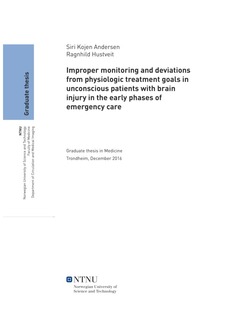Improper monitoring and deviations from physiologic treatment goals in unconscious patients with brain injury in the early phases of emergency care
Master thesis
Permanent lenke
http://hdl.handle.net/11250/2443630Utgivelsesdato
2016Metadata
Vis full innførselSamlinger
Sammendrag
Introduction: Traumatic brain injury (TBI), out-of-hospital cardiac arrest (OHCA) and intracerebral- and subarachnoid haemorrhage (ICH/SAH) are acute conditions that may impair brain circulation and oxygenation. Physiological variables such as blood pressure, oxygen saturation and end tidal CO2-levels need to be well regulated to prevent complications that may cause secondary brain injury. Adequate physiological monitoring in the pre-hospital and early hospital phase is demanding. The aim of this study was to observe the extent of physiological deviations and the degree of monitoring in patients with acute brain damage or -illness in the early phases of emergency care.
Method and materials: Patients with ICH/SAH, OHCA and severe TBI treated by the Physician-staffed Emergency Medical Service (P-EMS) and admitted to St Olav’s Hospital between September and December 2016 were included. The patients’ physiological variables were monitored from the site of injury/illness until the first three hours in the intensive care unit (ICU). Physiological deviations were defined as deviations from predefined target values. Each patient and its physiological course are descriptively presented.
Results: 13 patients were included in the study, of which 38% survived. The most frequent condition was OHCA. The mean time without any monitoring of physiological variables was 9 minutes (range 0-29 min.). The proportion of five-minute periods without any monitoring in the prehospital phase was 29%, 47% and 56% for oxygen saturation, end-tidal CO2 and systolic blood pressure, respectively. For the Emergency Department these proportions were 57%, 71% and 56%, respectively. Oxygen saturation was the physiological variable with the most deviations from the target value (mean 2.4, range 1-10), and was the most monitored value in the pre-hospital phase.
Conclusion: The patients in the study experienced frequent deviations in blood pressure, oxygen saturation and end tidal CO2-levels, both in the pre- and in-hospital phase. Physiological monitoring was often late initiated, and there was a considerable amount of missing observations in the period from site of injury to admittance to the ICU.
